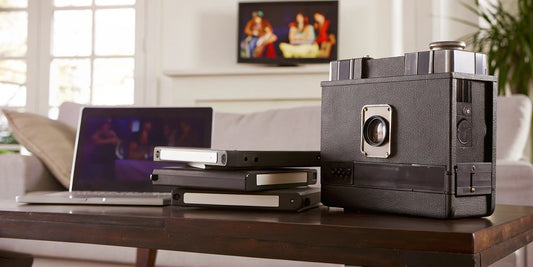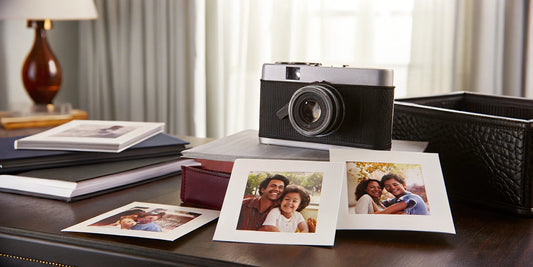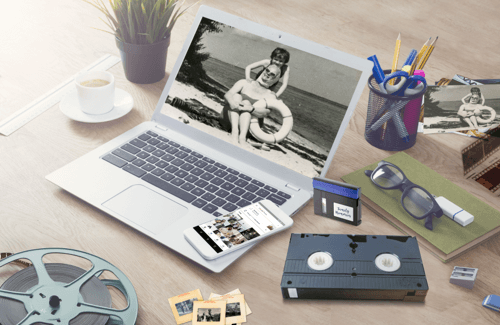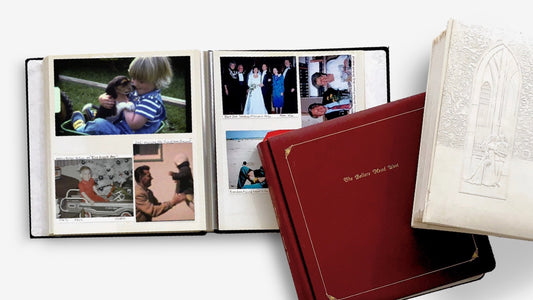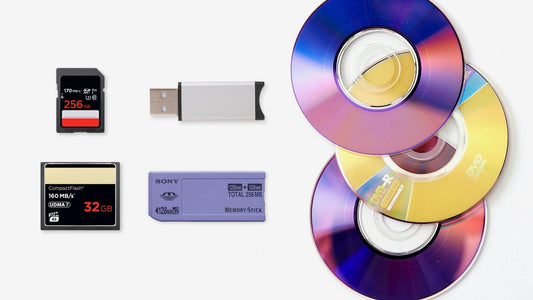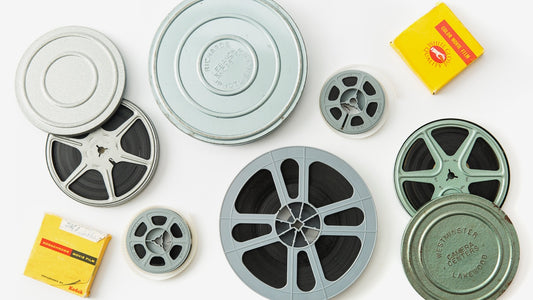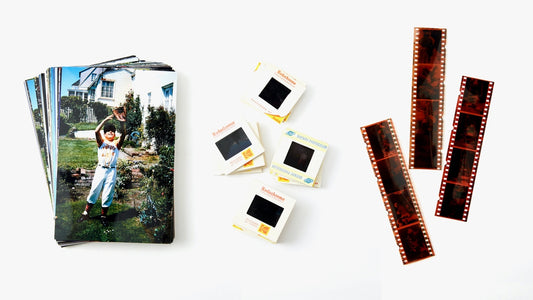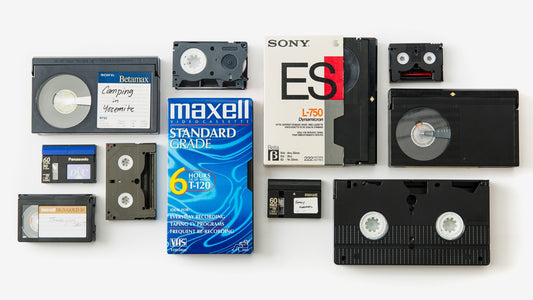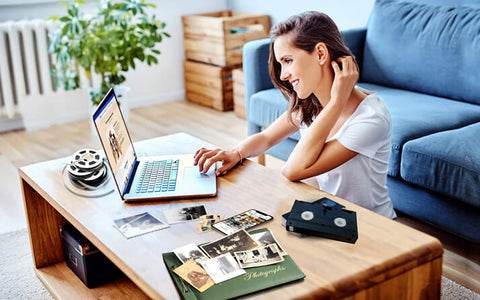A box of old tapes can feel like a time capsule full of your family’s most cherished moments—first steps, birthday parties, and holiday gatherings. But when those tapes are in the obscure MicroMV format, that time capsule is locked shut. Without the original, working camcorder, those memories are unwatchable, sitting in storage and slowly fading away. Bringing those moments back to life is about more than just a technical project; it’s about reconnecting with your family’s history. The key to unlocking that history is to convert MicroMV tapes to digital. We’ll show you how to turn those inaccessible tapes into vibrant digital files you can easily watch, share, and enjoy with loved ones.
Key Takeaways
- Prioritize Your MicroMV Tapes: This rare format is a ticking clock. The tapes themselves are degrading, and the camcorders required for playback are now obsolete, making professional conversion the most practical way to save your videos.
- Weigh Your Conversion Options: A DIY project requires hunting down rare equipment and a significant time investment. For guaranteed quality and peace of mind, a professional service like YesVideo handles all the technical work, ensuring your fragile tapes are treated with care.
- Create a Bulletproof Backup Plan: Once your videos are digitized, save them as versatile MP4 files. To truly protect them, store copies in at least two separate places—for example, on a physical USB drive and also in a secure cloud account—to safeguard against device failure or loss.
What is a MicroMV Tape?
If you’ve stumbled upon a tiny cassette tape, smaller than even a MiniDV, you might be holding a MicroMV tape. This format was Sony’s attempt to make camcorders even more compact, but it had a very short run in the early 2000s. Because they were only on the market for a few years, these tapes are relatively rare, and the equipment needed to play them is even harder to find. Understanding what makes this format unique is the first step toward saving the precious memories stored on them.
A Quick Look Back at the MicroMV
Sony introduced the MicroMV format in 2001 as the smallest videotape available. While the tiny size was innovative, the tapes themselves rely on magnetic tape technology, which unfortunately doesn't stand the test of time. Over the years, the magnetic particles that hold your video data can degrade, causing your home movies to look faded, blurry, or full of static. This natural decay means that with each passing year, the risk of losing those irreplaceable moments—like a first birthday or a family vacation—grows. Preserving them requires a modern solution, like a professional video transfer to a digital format.
Why You Should Convert Your Tapes Now
The biggest challenge with MicroMV tapes is a two-part problem: the tapes are degrading, and the camcorders that play them are nearly impossible to find. Even if your tapes are in perfect condition, you likely don't have a working MicroMV camcorder to watch them. This scarcity of hardware makes accessing your memories a huge hurdle. Combining this with the inevitable decay of the magnetic tape itself creates a real sense of urgency. Converting your tapes to a digital format is the only way to ensure they are safe, accessible, and easy to share with family for generations to come.
Spot the Signs of Tape Degradation
You can often tell if a tape is in trouble just by looking at it. Before you attempt to play a MicroMV tape (if you can even find a player), take a moment to inspect it. Gently handle the cassette and see if the casing feels brittle or sticky. A musty or moldy smell is another clear warning sign that moisture has damaged the tape. Look through the small window on the cassette to check the tape ribbon itself. If you see any white, powdery residue, which could be mold, or notice that the tape looks wrinkled or gooey, it's suffering from degradation. These are all signs that you should seek a professional transfer service right away to salvage what you can.
Your Conversion Options: DIY vs. Professional
When you decide it’s time to digitize your MicroMV tapes, you have two main paths you can take: you can tackle the project yourself, or you can hand it over to a professional service. There’s no single right answer—the best choice really comes down to your technical comfort, your budget, and how much time you’re willing to spend. A DIY approach gives you complete control over the process, but it also means you’re responsible for every step, from finding the right equipment to troubleshooting any issues that pop up. On the other hand, a professional service handles all the technical work for you, offering a simple way to get high-quality results without the headache. Let’s break down what each option looks like so you can figure out which one is the right fit for you and your precious memories.
Comparing Quality and Results
The quality of a DIY conversion depends entirely on your equipment and expertise. To do it yourself, you’ll need a working MicroMV camcorder with a FireWire port, the correct cables, and a computer that can capture the footage. While this can produce a good result, the final quality can be inconsistent if your camcorder’s playback heads are worn or if you run into software glitches. Professional services, however, use specialized, well-maintained equipment designed for high-quality video transfer. Technicians handle your tapes with care, ensuring the best possible playback and capture, which generally leads to a cleaner, more reliable digital copy of your memories.
Breaking Down the Costs
At first glance, a DIY project might seem like the cheaper option, but the costs can add up. If you don’t already own a working MicroMV camcorder, you’ll have to find and buy one, which can be difficult and expensive for such an obsolete format. You’ll also need to factor in the cost of cables and any necessary software. Professional services have a more straightforward pricing model, typically charging a flat fee per tape. This upfront cost covers the entire process, from transfer to digital delivery. You’re paying not just for the conversion itself, but for the convenience, peace of mind, and the expertise of trained professionals handling your irreplaceable tapes.
How Long Will It Take?
The time commitment is one of the biggest differences between the two options. Converting tapes yourself is a real-time process, meaning a 60-minute tape will take at least 60 minutes to capture—and that doesn’t include setup, testing, or troubleshooting. A box of tapes could easily turn into a project that takes up several weekends. When you use a professional service, the process is much more hands-off for you. Most companies, including YesVideo, complete the film transfer and return your digital files within a few weeks. You simply pack up your tapes and send them in, saving yourself hours of technical work and letting the experts handle the rest.
How to Convert Tapes Yourself
If you’re feeling adventurous and have some time on your hands, converting your MicroMV tapes yourself can be a rewarding project. This path gives you complete control over the process, from the equipment you use to the final file format. It’s a great option if you enjoy hands-on tech projects and only have a few tapes to convert. However, it does require a bit of patience and a specific set of tools to get the job done right. Think of it as a weekend project that will bring your old memories back to life, but be prepared for a learning curve. Before you start, it’s important to understand what you’ll need and the steps involved to ensure your precious home movies are transferred safely and successfully.
The Equipment You'll Need
First things first, you’ll need the right gear. The most crucial piece of equipment is your original MicroMV camcorder, as these tapes require their native device for playback. You'll also need a video conversion box, which acts as a bridge between your analog camcorder and your digital computer. This little device translates the video signal so your computer can understand it. Finally, you'll need the correct cables—typically RCA or S-Video cables—to connect your camcorder to the conversion box, and a USB cable to connect the box to your computer. Make sure you have everything on hand before you begin to avoid any mid-project scrambles.
Find the Right Software
Once your hardware is set up, you’ll need video capture software to record the footage onto your computer. Some conversion boxes come bundled with basic software, which can be a great starting point. However, you can also find more advanced programs online that offer greater control over recording quality, editing, and file formats. Popular options range from free software like OBS Studio to paid programs like Adobe Premiere Pro. The software you choose will be your command center for the entire recording process, so it’s worth spending a little time finding one you’re comfortable with.
A Step-by-Step Guide
With your gear and software ready, you can start the conversion. It’s a real-time process, meaning a 60-minute tape will take 60 minutes to capture. Here’s a simple breakdown of the steps:
- Connect your MicroMV camcorder to the video conversion box with RCA or S-Video cables.
- Connect the conversion box to your computer using a USB cable.
- Insert your MicroMV tape into the camcorder and set it to VCR or Playback mode.
- Open your video capture software on your computer.
- Press play on your camcorder, then immediately click the ‘Record’ button in your software.
- Once the tape is finished, stop the recording and save your new digital file.
Troubleshoot Common Problems
The DIY route can sometimes come with a few hiccups. A common mistake is choosing the wrong file format, which can lead to compatibility issues later on. To avoid this, export your videos as MP4 files, as they are widely supported across devices. Another frequent issue is not backing up your new digital files immediately. Always create at least one copy on an external hard drive or use a cloud storage service. This ensures that after all your hard work, your digitized memories are safe from accidental deletion or computer crashes. Taking a few preventative steps can save you a lot of headaches down the road.
Check Your Conversion Quality
Before you even press play, take a close look at your tapes. If they feel sticky or have a musty smell, they might be showing signs of degradation, which can affect the final video quality. While you can’t reverse this damage, being aware of it helps set realistic expectations for the outcome. After you’ve captured a video, do a quick quality check. Watch a few minutes of the new digital file to ensure the audio is synced with the video and there are no major glitches. If you’re digitizing a large collection or find your tapes are in poor shape, consider a professional video transfer service to guarantee the best possible quality.
The Best Professional Conversion Services
If the DIY route feels a bit overwhelming, don't worry. Handing your precious memories over to a professional service is a fantastic option. It saves you the time and hassle of hunting down old equipment and learning new software. Plus, you get the peace of mind that comes with knowing your tapes are in the hands of experts who do this every single day. These companies have specialized equipment designed to get the best possible quality from old media, and they know how to handle fragile tapes that have been sitting in storage for years.
Choosing a professional service means you’re prioritizing convenience and quality. You simply pack up your tapes, send them off, and wait for your new digital files to arrive. It’s a straightforward process that takes the guesswork out of preserving your family’s history. From services that send you a pre-paid box to fill, to those with detailed online tracking, there are plenty of great companies that can help you convert your MicroMV tapes. Let’s walk through some of the most trusted names in the business so you can find the perfect fit for your project.
YesVideo
With over 20 years of experience, YesVideo is a name that families have trusted for a long time. They offer a comprehensive service for converting MicroMV tapes, focusing on preserving the quality of your original videos. What I appreciate is that every order is processed by hand right here in the USA, which adds a layer of trust and care. Their online platform is also super user-friendly, making it simple to place your order and track its progress from start to finish. It’s a solid choice if you’re looking for a reliable service that combines expertise with a seamless customer experience, ensuring your home movies are safely digitized for you and your family to enjoy.
Legacy Box
You’ve probably seen their ads, and for good reason. Legacy Box has made a name for itself by making the entire digitization process incredibly simple. They specialize in digitizing old media, including MicroMV tapes. Their whole model is built around ease of use: they send you a box with a pre-paid shipping label, you fill it with your tapes, and they handle the rest. In return, you get high-quality digital files of your cherished memories. It’s a very straightforward, all-in-one solution that’s perfect if you want to avoid any complications and just get the job done with a service that has the process down to a science.
Kodak Digitizing
Kodak is a legendary name in the world of photography and film, so it’s no surprise they offer a digitizing service. With Kodak Digitizing, you can convert your MicroMV tapes into modern digital files or DVDs. Their service is centered on the importance of preserving your memories before the tapes have a chance to degrade any further. By converting your videos, you’re ensuring they are safely stored and accessible for years to come. If you trust the Kodak name and are looking for a dependable way to safeguard your home movies, this is a reliable option to consider for your conversion project.
Southtree
Southtree is another popular service that provides a dependable way to convert MicroMV tapes to either DVDs or digital files. They really put an emphasis on the importance of preserving your memories and make a promise to maintain the original quality of your footage during the transfer process. Like its sister company, Legacy Box, Southtree is designed to be easy and convenient for you. They understand that these tapes hold irreplaceable moments, and their service is built to handle them with care. If you’re looking for a straightforward service that prioritizes quality and the safety of your memories, Southtree is definitely worth checking out.
Memories Renewed
As their name suggests, Memories Renewed is all about bringing your old videos back to life. They focus on converting various video formats, including MicroMV, into digital files. A key part of their service is their commitment to quality preservation, ensuring that the digital version looks as good as the original tape allows. They also offer multiple output options, which is great because it gives you the flexibility to choose the format that best suits your needs, whether you want to edit the files later or just easily share them with family. This flexibility makes them a strong contender, especially if you have specific plans for your newly digitized videos.
iMemories
iMemories offers a user-friendly service to convert your MicroMV tapes into digital formats, making sure your memories are preserved in high quality. Their process is designed to be simple from the moment you place your order. Once your tapes are digitized, they offer various delivery options for your videos, including their own streaming app, which can be a convenient way to view and share your memories on different devices. This blend of a simple process and modern viewing options makes iMemories an appealing choice for families who want an easy way to not only digitize but also enjoy their old home movies.
Choose Your Digital Format and Storage
Congratulations, the hardest part is over! Your MicroMV tapes have been converted into digital files, and you’re so close to having those memories ready to enjoy and share. But before you start that movie marathon, there are a few final—and very important—decisions to make. This last part of the process is all about ensuring your memories are safe, accessible, and easy to view for years to come. Think of it as building a beautiful, secure new home for your family’s most precious moments.
Choosing the right digital format, deciding on a storage solution, and creating a solid backup plan might sound technical, but it’s simpler than you think. Getting these details right means you won’t have to worry about files that won’t play, a hard drive crash wiping out everything, or family members being unable to open the videos you send them. It’s the key to true peace of mind. Let’s walk through how to set everything up perfectly, so you can relax and know your memories are protected for good.
Pick the Best File Format
When you digitize a video, you have to save it as a specific file type. For home movies, the best and most common choice is MP4. Think of it as the universal language for video files. An MP4 file gives you a great balance of crisp, clear quality without creating a massive file that’s difficult to store or share. This format is compatible with virtually any device you can think of—Macs, PCs, smartphones, tablets, and smart TVs. By choosing MP4, you’re making it easy to watch, edit, and share your memories without running into frustrating compatibility issues down the road.
Decide Where to Store Your Files
Once your videos are in a digital format, you need a place to keep them. You have a few great options. You can save them to a physical device like a USB thumb drive, which is perfect for plugging directly into a TV or computer and makes a wonderful gift. Another option is a digital download, where your files are delivered via a secure cloud link. This is the fastest way to get your memories and makes sharing them with family online a breeze. YesVideo offers digital media transfer that includes cloud storage, giving you instant access from anywhere.
Create a Smart Backup Plan
If you take away only one piece of advice, let it be this: back up your digital files. A single copy on your computer is a recipe for heartbreak if the hard drive fails. A smart backup plan involves having at least two copies of your files in different places. For example, keep one copy on an external hard drive that you store safely at home. For the second copy, use a cloud storage service. This ensures that even if something happens to your computer or the hard drive, your precious memories are still safe and sound in a separate location.
A Quick Guide to Format Compatibility
Ensuring your new digital files are compatible with your devices is key to enjoying them without any technical headaches. As we covered, choosing a universal file format like MP4 is the most important step. This prevents that frustrating moment when you try to play a video on a new laptop or send it to a relative, only to find they can't open it. When you use a professional video transfer service, they handle all the technical details to ensure your files are optimized for modern playback, so you can just focus on reliving your favorite moments.
My Top Tips for a Smooth Conversion
Embarking on a DIY conversion project is exciting, but a little prep work goes a long way in preventing headaches. Over the years, I’ve learned that a few simple checks can make the difference between a cherished digital memory and a frustrating afternoon. These are my go-to tips for making your MicroMV transfer process as seamless as possible, ensuring your home movies look their best in their new digital format.
Check Your Equipment
Before you plug anything in, make sure you have the right tools for the job. Your setup will likely include your MicroMV camcorder for playback, a computer to store the files, and a conversion box to bridge the two. This box is key—it translates the analog signal from your tape into a digital file your computer can understand. There are many options out there, so do a little research to find one that’s compatible with your camera and computer. The quality of your equipment, especially the converter, will directly influence the quality of your final video transfer.
Assess Your Tapes First
Your tapes have been sitting for a while, so it’s wise to give them a quick inspection before you press play. Gently handle the tape and check for any red flags. A musty smell, a sticky residue on the tape itself, or visible dust and flaking are all signs of degradation. These issues can not only result in a poor-quality transfer with glitches and audio drops but could also damage the delicate playback heads inside your camcorder. If a tape seems particularly fragile or damaged, it might be best to set it aside for professional handling to avoid any further harm.
Connect Your Gear Correctly
A solid connection between your devices is essential for a clean transfer. For MicroMV camcorders, you’ll typically use either an Audio/Video (A/V) cable or an i.LINK (also known as IEEE 1394 or FireWire) cable. The i.LINK connection generally provides a higher-quality digital-to-digital transfer if your camera and computer both have the port. Whichever you use, ensure the cables are plugged in securely at both ends. A loose connection can cause flickering video or audio cutouts, so it’s worth taking a moment to double-check that everything is snug before you start recording.
Organize Your Digital Files
Once your video is on your computer, the work isn’t quite done. It’s easy to make common mistakes like saving files with generic names or forgetting to back them up. Get into the habit of creating a clear and consistent organizational system right away. Create folders for specific events or years, and give each file a descriptive name, like "Hawaii_Vacation_2002.mp4." This will save you so much time later when you’re looking for a specific moment. Also, think about how you'll share these memories and make sure you have a reliable backup plan in place for your new digital media.
Perform a Final Quality Check
After each tape is converted, take the time to watch the new digital file from beginning to end. Look for any quality issues, like audio that’s out of sync with the video, visual glitches, or spots where the transfer may have dropped out. This is also a good time to confirm the tape format. You might have a box labeled "Family Videos" that contains a mix of MicroMV, VHS, and other formats. If you discover different types of tapes, you’ll need specific equipment for each one, which can complicate a DIY project. Identifying everything upfront helps you create a clear plan for getting all your memories digitized.
What to Expect to Pay
Understanding the costs involved in converting your MicroMV tapes will help you decide between a DIY project and a professional service. The final price tag depends on the number of tapes you have, the equipment you need, and the final format you choose for your digital memories. Let's break down the potential expenses so you can find the best option for your budget.
The Cost of a DIY Setup
If you decide to handle the conversion yourself, your main expense will be the hardware. You’ll need a working MicroMV camcorder and a special conversion box that translates the camera's analog signal into a digital file for your computer. The price of these video capture devices can vary quite a bit depending on their quality and features. Don't forget to factor in the cost of your time, as the DIY process can be quite involved. If your original camera no longer works, finding a replacement can be another significant and sometimes difficult expense, as these models are no longer in production.
How Professional Services are Priced
Opting for a professional service is often more straightforward when it comes to pricing. Most companies, including YesVideo, charge on a per-tape basis. This makes it easy to calculate your total cost upfront. For example, some services charge around $15 per tape for a standard conversion. At YesVideo, we simplify the process with our prepaid, crush-proof boxes that you can fill with your tapes. This approach takes the guesswork out of the equation and ensures your precious memories are handled by experts from start to finish. Our video transfer service is designed to make preservation simple and secure.
Look for Bundles and Deals
Whether you have a handful of tapes or a massive collection, it’s always a good idea to look for ways to save. Many digitizing companies run promotions and offer bundle deals that can significantly lower the cost per tape. You might find seasonal discounts or special codes that offer a percentage off your total order. Before committing, take a moment to check the company’s website for any current offers. A little research can go a long way in making your project more affordable. You can always find the latest YesVideo promotions on our homepage.
Factor in Extra Services
When you're budgeting for a professional conversion, remember to consider any extra services you might need. Most companies offer different ways to receive your final files, such as a digital download, a custom USB drive, or DVDs. Each option may have a different price point. Additionally, while most services can handle minor tape repairs like fixing a simple splice, they typically don't address more serious issues like mold or broken cassette housings. Be sure to ask what’s included in the base price and what might count as an add-on. Understanding all your digital media options will help you get exactly what you want.
How to Protect Your New Digital Memories
Getting your MicroMV tapes converted is a huge win, but the work isn’t quite done. Now that you have these precious digital files, the next step is to create a system to protect them for all the years to come. A little planning right now ensures your family’s moments are safe from computer crashes, accidental deletions, or lost hard drives. Think of it as building a digital time capsule that you and your family can always access.
Follow Best Practices for Storage
The single most important rule for digital preservation is to have more than one copy of your files. A surprisingly common mistake people make after digitizing is "not backing up your video files," leaving their only copy on a single computer. The best practice is to store your memories in at least two separate places. For example, you can keep one copy on your laptop or desktop computer and another on an external hard drive. This simple step immediately protects your videos from being lost if one device fails.
Set Up Your Backup System
A reliable backup system uses a mix of physical and cloud-based storage. Along with a physical copy on an external hard drive or USB, consider using a cloud storage service. This creates an off-site backup, protecting your files from localized events like fire, theft, or flood. When you get your memories digitized, you can often choose your storage format. YesVideo’s digital media transfer service, for instance, offers both a shareable online account and the option to get your files on a USB drive, giving you a head start on your backup plan.
Keep Everything Organized
You’ll thank yourself later if you take a few minutes to organize your new video files. Start by creating a main folder called "Family Videos" or something similar. Inside, make subfolders organized by year, event, or family member—whatever makes the most sense to you. Use clear, consistent naming conventions for the files themselves, like "Hawaii-Vacation-1999-Tape1.mp4." This simple system makes it easy to find exactly what you’re looking for, so you can spend less time searching and more time reliving your favorite moments.
Ensure Your Memories Last Forever
The quality of your digital memories depends heavily on the condition of the original tapes. Before you even begin a conversion, take a moment to assess your MicroMV tapes. If a tape has a "sticky feeling or smell," it could be a sign of binder hydrolysis, a form of degradation that can damage the tape and your playback equipment. If you notice any signs of wear, your safest option is to use a professional video transfer service. Experts have the tools and experience to handle fragile media and capture the best possible quality from aging tapes.
Related Articles
- How to Find Cassette Tape Repair Service Near Me – YesVideo
- What To Do With Old VHS Tapes: Recycle, Convert & More – YesVideo
- Video Tape to Digital: DIY or Pro? Your Best Bet – YesVideo
- The Ultimate Guide to Convert Tapes to Digital – YesVideo
- How to Convert Cassette to Digital: A Guide – YesVideo
Frequently Asked Questions
My tapes have been sitting in a box for 20 years and seem fine. Why should I convert them now? The biggest reason is that the clock is ticking on two fronts. First, the magnetic tape inside your MicroMVs is slowly breaking down, which can cause fading, static, and permanent loss of your videos. Second, the camcorders required to play these specific tapes are incredibly rare and difficult to find in working condition. Converting them now is the best way to rescue those memories before the tapes degrade further or the equipment to play them disappears entirely.
I'm pretty good with technology. Is there any reason I shouldn't just convert my MicroMV tapes myself? While a DIY project can be rewarding, the main challenge with MicroMV is the hardware. Finding a working camcorder from the early 2000s is a difficult and often expensive hunt. Even if you find one, its internal parts may be worn out, which can result in a poor-quality transfer or even damage your tape. A professional service removes that entire equipment headache and uses well-maintained, professional-grade decks to ensure the best possible picture and sound from your home movies.
I found my tapes, and they feel a little sticky or smell musty. Can they still be saved? A sticky feel or musty smell usually points to tape degradation from moisture, but it doesn't mean all is lost. These tapes are very delicate, and trying to play them in this condition can cause permanent damage. This is a situation where a professional service is your safest bet. Technicians have experience with fragile media and use specialized methods to carefully clean and play the tapes, giving you the best chance of recovering the footage.
What exactly do I get back when I send my tapes to a service like YesVideo? You receive your original tapes back, along with high-quality digital versions of your memories. These are typically saved as versatile MP4 files, which are easy to watch, share, and edit on any modern device. You can choose to have your files delivered through a secure cloud account for instant access, loaded onto a convenient USB drive, or both.
After reading all this, what is the very first thing I should do with my box of tapes? The best first step is to simply organize your collection. Group the tapes together and give them a quick visual inspection for any obvious signs of damage, like a cracked casing. Don't try to play them. Once you have a sense of how many tapes you have and their general condition, you can make a clear decision about whether you want to begin the DIY process or choose a professional service to handle the conversion for you.


